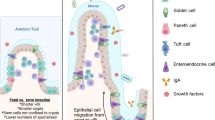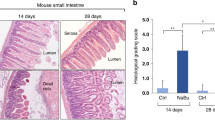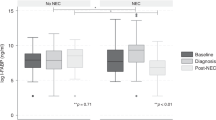Abstract
Necrotizing enterocolitis (NEC) is a serious gastrointestinal disorder of preterm infants. Other than an association with prematurity and gastrointestinal feeding, no single factor or mechanism has been consistently linked to this disease. We have previously demonstrated that Escherichia coli isolates obtained from the stool of infants with NEC caused NEC-like injury in a weanling rabbit ileal loop model; this injury, in turn, could be blocked by coinfection with selected Gram(+) bacteria(Enterococcus faecium) isolated from asymptomatic controls. Using Caco-2 cells in a trans-well system, we now demonstrate that the same E. coli isolates can cross epithelial cell monolayers in the absence of ultrastructural change or damage. These results with E. coli contrast with those seen with Salmonella typhimurium, which passed through the monolayer at a higher rate and were associated with striking ultrastructural damage. Transcytosis of E. coli was reduced 3-5-fold in the presence of E. faecium previously shown to block NEC-like injury in the loop model. There was a mild increase in the rate of E. coli transcytosis when studies were conducted with younger, undifferentiated cells; these immature cells had no brush border, had decreased production of brush border-specific enzymes, but retained well defined tight junctions, as demonstrated by transepithelial electrical resistance and electron microscopy. A further reduction/complete blockage of E. coli transcytosis was observed when E. faecium was used as the coinfectant in studies with these undifferentiated cells. We hypothesize that the ability of E. coli to cross epithelial cell layer is a critical initial step in the cascade of events which lead ultimately to NEC; blockage or reduction in E. coli transcytosis in the presence of certain Gram(+) organisms may play a significant role in prevention of NEC.
Similar content being viewed by others
Log in or create a free account to read this content
Gain free access to this article, as well as selected content from this journal and more on nature.com
or
Abbreviations
- NEC:
-
necrotizing enterocolitis
- TEER:
-
transepithelial electrical resistance
- EPEC:
-
enteropathogenic E. coli
- DMEM:
-
Dulbecco's modified Eagle's medium
- ANOVA:
-
analysis of variance
References
Carbonaro CA, Clark DA, Elseviers D 1988 A bacterial pathogenicity determinant associated with necrotizing enterocolitis. Microb Pathog 5: 427–436
Kliegman RM 1990 Models of pathogenesis of necrotizing enterocolitis. J Pediatr 117: 52–55
Kosloske AM 1990 A unifying hypothesis for pathogenesis and prevention of necrotizing enterocolitis. J Pediatr 117: 568–574
Kien CL 1990 Colonic fermentation of carbohydrate in the premature infant: possible relevance to necrotizing enterocolitis. J Pediatr 117: 552–558
Clark DA, Miller MJS 1990 Intraluminal pathogenesis of necrotizing enterocolitis. J Pediatr 117: 564–567
Kleigman RM, Walker WM, Yolken RH 1993 Necrotizing enterocolitis: research agenda for a disease of unknown etiology and pathogenesis. Pediatr Res 34: 701–708
Gupta S, Morris JG Jr, Panigrahi P, Nataro JP, Glass RI, Gewolb IH 1994 Endemic necrotizing enterocolitis:lack of association with a specific infectious agent. Pediatr Infect Dis J 13: 728–734
Panigrahi P, Gupta S, Gewolb IH, Morris JG Jr 1994 Occurrence of necrotizing enterocolitis may be dependent on patterns of bacterial adherence and intestinal colonization: studies in Caco-2 tissue culture and weanling rabbit models. Pediatr Res 36: 115–121
Finlay BB, Falkow S 1989 Common themes in microbial pathogenesis. Microbiol Rev 53: 210–230
Finlay BB, Falkow S 1990 Salmonella interactions with polarized human intestinal Caco-2 epithelial cells. 162: 1096–1102
SmallPLC Isberg RR, Falkow S 1987 Comparison of the ability of enteroinvasive Escherichia coli, Salmonella typhimurium, Yersinia psudotuberculosis, and Yersina enterocolitica to enter and replicate within HEp-2 cells. Infect Immun 55: 1674–1679
Finlay BB, Falkow S 1988 Comparison of invasion strategies used by Salmonella cholerae-suis, Shigella flexneri and Yersinia enterocolitica to enter cultured animal cells: endosome acidification is not required for bacterial invasion or intracellular multiplication. Biochimie 70: 1089–1099
Levine MM 1987 Escherichia coli that cause diarrhea: enterotoxigenic, enteropathogenic, enteroinvasive, enterohemorrhagic, and enteroadherent. J Infect Dis 155: 377–389
Hidalgo IJ, Raub TJ, Borchardt RT 1989 Characterization of the human colon carcinoma cell line (Caco-2) as a model system for intestinal epithelial permeability. Gastroenterology 96: 736–749
Dahlquist A 1968 Assay for intestinal disaccharidases. Anal Biochem 22: 99–107
Azad M, Lebenthal E 1990 Role of rat intestinal glucoamylase in glucose polymer hydrolysis and absorption. Pediatr Res 28: 166–170
Ballance WA, Dahms BB, Shenker N, Kleigman RM 1990 Pathology of necrotizing enterocolitis: a ten year experience. J Pediatr 117: 524–532
Joshi VV, Winston Y, Kay S 1973 Neonatal necrotizing enterocolitis: histologic evidence of healing. Am J Dis Child 126: 113–116
Berg RD 1981 Promotion of the translocation of enteric bacteria from the gastrointestinal tracts of mice by oral treatment with penicillin, clindamycin, or metronidazole. Infect Immun 33: 854–861
Wells CL, Jechorek RP, Maddaus MA, Simmons RL 1988 Effects of clindamycin, and metronidazole on the intestinal colonization and translocation of enterococci in mice. Antimicrob Agents Chemother 32: 1769–1775
Alverdy JC, Aoys E, Moss GS 1988 Total parenteral nutrition promotes bacterial translocation from the gut. Surgery 104: 185–190
Fox AD, Kripke SA, Moss GS, De Paula J 1988 Effect of glutamine supplemented enteral diet on methotrexate-induced enterocolitis. JPEN 12: 325–331
Maejima K, Deitch EA, Berg RD 1984 Bacterial translocation from the gastrointestinal tract of rats receiving thermal injury. Infect Immun 43: 6–10
Rush BF, Sori AJ, Murphy TF 1988 Endotoxemia and bacteremia during hemorrhagic shock Link between trauma and sepsis? Ann Surg 207: 549–554
Baker JW, Deitch EA, Berg RD, Specian RD 1988 Hemorrhagic shock induces bacterial translocation from the gut. J Trauma 28: 896–906
Papa M, Halperin Z, Rubinstein E, Orenstein A, Gafin S, Adar R 1983 The effect of ischemia of the dog's colon on transmural migration of bacteria and endotoxin. J Surg Res 35: 264–269
Pinto M, Robine-Leon S, Appay MD, Kedinger M, Triadou N, Dussaulx E, Lacroix B, Simon-Assmann P, Haffen K, Fogh J, Zweibaum A 1983 Enterocyte-like differentiation and polarization of the human colon carcinoma cell line Caco-2 in culture. Biol Cell 47: 323–330
Chantret I, Barbat A, Dussaulx E, Brattain MG, Zweibaum A 1988 Epithelial polarity, villin expression, and enterocytic differentiation of cultured human colon carcinoma cells: a survey of twenty cell lines. Cancer Res 48: 1936–1942
Panigrahi P, Tall BD, Russell RG, Detolla LJ, Morris JG Jr 1990 Development of an in vitro model for study of non-O1Vibrio cholerae virulence using Caco-2 cells. Infect Immun 58: 3415–3424
Rigothier MC, Coconnier MH, Servin AL, Gayral P 1991 A new in vitro model of Entamoeba histolytica adhesion, using the human colon carcinoma cell line Caco-2: a scanning electron microscopic study. Infect Immun 59: 4142–4146
Konkel ME, Mead DJ, Hayes SF, Cieplak W Jr 1992 Translocation of Campylobacter jejuni across human polarized epithelial cell monolayer cultures. J Infect Dis 166: 308–315
Grant CC, Konkel ME, Cieplak W Jr, Topmkins LS 1993 Role of flagella in adherence, internalization, and translocation of Campylobacter jejuni in polarized and nonpolarized epithelial cell cultures. Infect Immun 61: 1764–1771
Morisset J, Solomon TE 1991 Growth of the Intestinal Tract. CRC Press, FL, pp 167–168
Anderson JM, Van Itallie CM, Peterson MD, Stevenson BR, Carew EA, Mooseker MS 1989 ZO-1 mRNA and protein expression during tight junction assembly in Caco-2 cells. J Cell Biol 109: 1047–1056
Cruz N, Qi L, Alvarez X, Berg RD, Deitch EA 1994 The Caco-2 cell monolayer system as an in vitro model for studying bacterial-enterocyte interactions and bacterial translocation. J Burn Care Rehabil 15: 207–212
Donnenberg MS, Donohue-Rolfe A, Keush GT 1989 Epithelial cell invasion: an overlooked property of enteropathogenic Escherichia coli (EPEC) associated with an EPEC adherence factor. J Infect Dis 160: 452–459
Bilska JB, Galan JE, Falkow S 1993 Signal transduction in the mammallian cell during bacterial attachment and entry. Cell 73: 903–920
Kaiser D, Losick R 1993 How do bacteria talk to each other. Cell 73: 873–885
Lebenthal E 1989 Human Gastrointestinal Development. Raven Press, New York, pp 369–387
Author information
Authors and Affiliations
Additional information
Supported by National Institutes of Child Health and Human Development, National Institutes of Health Grant HD29735 (to P.P.).
This work was presented in part at the National Meeting, Society for Pediatric Research, May 6-11, 1995, San Diego, CA.
Rights and permissions
About this article
Cite this article
Panigrahi, P., Bamford, P., Horvath, K. et al. Escherichia coli Transcytosis in a Caco-2 Cell Model: Implications in Neonatal Necrotizing Enterocolitis. Pediatr Res 40, 415–421 (1996). https://doi.org/10.1203/00006450-199609000-00009
Received:
Accepted:
Issue date:
DOI: https://doi.org/10.1203/00006450-199609000-00009
This article is cited by
-
A randomized synbiotic trial to prevent sepsis among infants in rural India
Nature (2017)
-
TNF-α Induces Vectorial Secretion of IL-8 in Caco-2 Cells
Journal of Gastrointestinal Surgery (2010)
-
Current concepts regarding the pathogenesis of necrotizing enterocolitis
Pediatric Surgery International (2009)
-
Pathogenic Escherichia coli
Nature Reviews Microbiology (2004)



